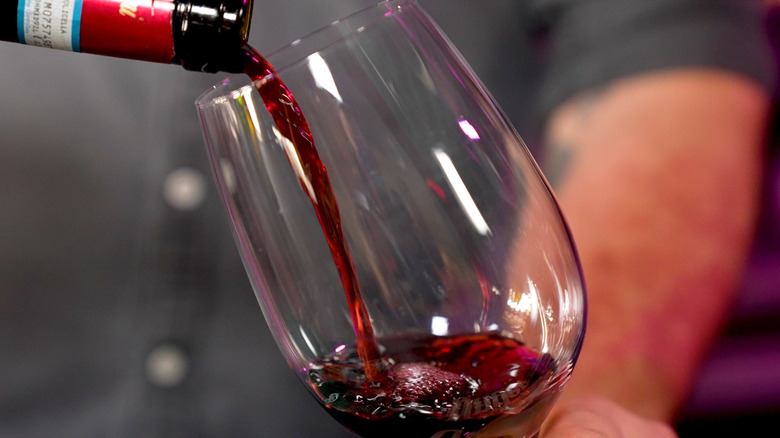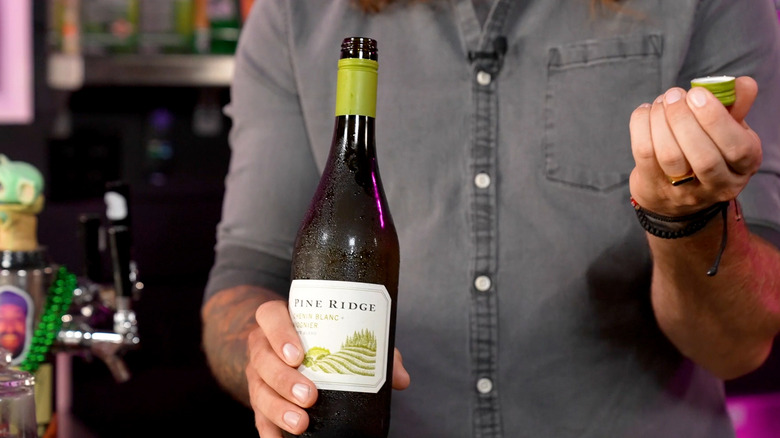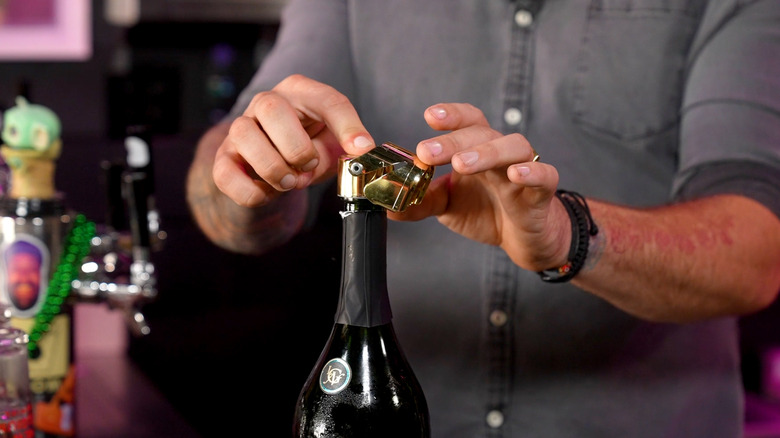How To Store Wine - You're Doing It Wrong All Wrong
We may receive a commission on purchases made from links.
If you like to enjoy the occasional glass of wine after a long day, then you might have a bottle or two on hand at all times — or perhaps you've just decided to start collecting vintage wines but aren't sure of the best way to keep them. Not all wines are created equally, and depending on the type, different storage methods apply. Craft bartender Kamaron Lockwood offers his advice on the best way to store all wines — the red, the white, and the bubbly.
Storage might seem like a small detail with an unopened bottle of wine, especially when it's an inexpensive bottle, but it actually makes a big impact. It is crucial to the wine-aging process that wine be stored correctly in order for its flavor and mouthfeel to get better over time. Important aspects like temperature, humidity, and oxygen levels help give meaning to the phrase "aging like fine wine."
Red wine should be stored cooler than room temperature
The truth is that room temperature varies per person — and it's likely too warm for a good red. "A lot of red wines I think sip preferably in the 55- to 65-degree [Fahrenheit] temperature range," Lockwood says. But he stresses that temperature isn't the be-all-end-all of wine storage; the humidity makes a big difference, too. "The sweet spot is right around 70% humidity."
This temperature and humidity range is meant to keep the cork moist. Avoid the mistake of storing wine bottles upright, which can dry out the cork. If the cork dries out, air can get into the wine, ultimately leading to oxidation, which damages the taste. This is why it's common to see wine bottles stored at an angle on shelves — when angled downward, the wine is always touching the cork, which helps keep it wet.
If you open a wine bottle but don't drink it all, Lockwood advises using an airtight stopper with a wine pump. "This will create an artificial cork that will reseal the wine and take the oxygen out of it so that way you don't lose any of the flavors." Lockwood notes that it's best to consume opened red wine within five days. And if you don't have a temperature-controlled storage spot at home, Lockwood suggests keeping red wine in a cool spot away from direct sunlight. Steer clear of the impulse to store it in your regular refrigerator, because that will alter the wine's profile. A properly stored, unopened bottle of vintage red wine can pretty much last indefinitely.
White wines should be stored at cooler temperatures than reds
The first thing Lockwood stresses about white wine is that you shouldn't shy away from a bottle with a screw cap. "Some people think [screw caps] are cheap and not flashy, but I think that they do a really good job of preserving the integrity of the wine," he says. Also, white wines can't be stored as long as reds. "One to three years is kind of the sweet spot," he notes, though this varies depending on the vintage and type.
Lockwood suggests storing your whites in the 45- to 50-degree Fahrenheit range and does not recommend standard refrigerator storage. Once opened, white wines will last about as long as red wines. "I think one to three days is ideal, but three to five on most white wines — it will hold and still have the integrity of all the flavors." If your wine bottle has a cork and not a screw top, the downward angle rule still applies in order to prevent the cork from drying out.
Sparkling wines can be stored the same way as white wines
Since sparkling wines are essentially just bubbly variations of white wine, they can follow the same storage technique. "Keep it in a nice cool place away from sunlight, and definitely start to chill it down maybe 30 to 45 minutes before you want to serve it," Lockwood says. This will get it to that ideal white wine temperature range, which improves its taste. "I really do think that it makes for a better experience with the carbonation and overall mouthfeel," he adds.
The downward angle storage method applies here, too. Lockwood recommends using a Champagne wine cage in the event of leftover sparkling wine to prevent any added oxygen from getting in. The phrase "wine cage" usually refers to the wire frame used on unopened bottles of Champagne to keep the cork in place, but once your bottle is open, you'll want to opt for a reusable wine cage or Champagne stopper that seals itself.
As the wine cage is clamped onto the bottle, the carbonation inside will increase the pressure in the bottle which will cause the stopper to expand, ultimately creating a tight seal. While this won't remove any existing oxygen, it does mean your bubbly will be ready for a perfect pour up to five days later. Drink it within one to three days, though, for the best flavor and feel.
Avoid common storage misconceptions, keep the cork wet, and stay aware of temperature — and you can have a perfect sip of leftover wine every time.


